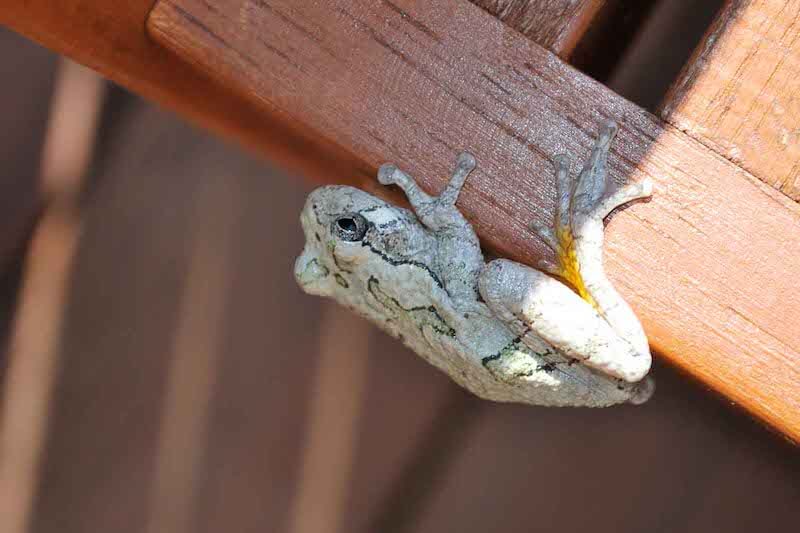There are many different species of tree frogs in the U.S. and 15 of them live in the various habitats of Alabama. The typical Alabama environments that attract tree frog populations include the coastal plains, small stream valleys, and shrub bogs. While most species are highly arboreal, coming down to the waters mostly for breeding, some individuals prefer ground-level vegetation. Learn interesting facts about tree frogs in Alabama and where you can find them hanging out in trees or by water bodies.
15 tree frogs in Alabama
1. Northern cricket frog
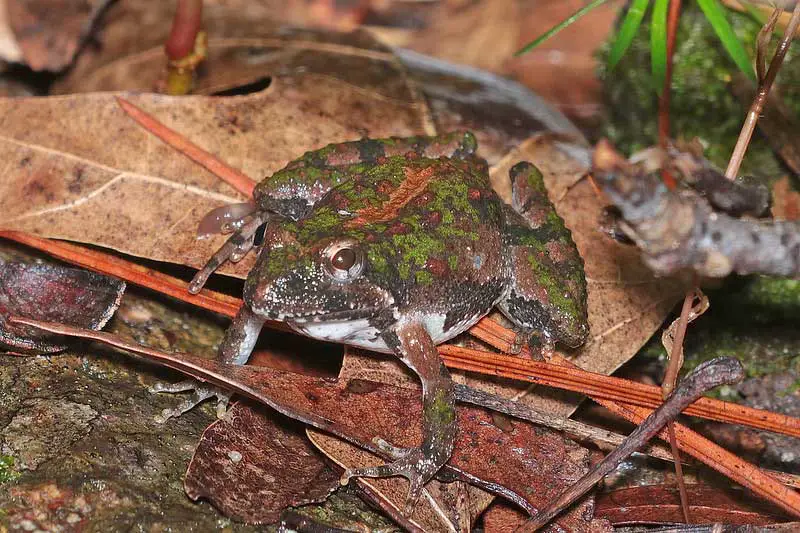
Scientific name: Acris crepitans
Unlike most smooth-skinned tree frogs, the Northern cricket frog is small and warty, growing around 0.75 to 1.5 inches long. They are various shades of brown, green, and gray with brown to orange stripes, long limbs, and no toe pads.
You can find them throughout Alabama near various aquatic habitats, such as ponds, streams, lakes, and floodplain pools. These frogs don’t climb as well as other tree frog species and aren’t found in high trees.
2. Southern cricket frog
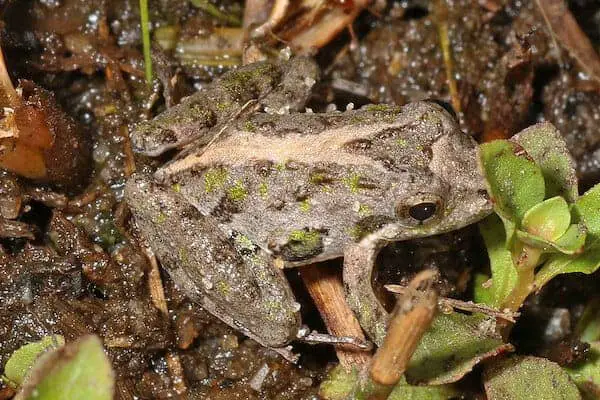
Scientific name: Acris gryllus
The southern cricket frog’s coloring varies between brown, gray, green, and black with yellow, red, or green dorsal stripes. They range in size from 0.75 to 1.5 inches long and make a gick gick call resembling pebbles being clicked together.
You can find them in the coastal plains of Alabama, normally below the fall line. Some populations are also in the Appalachian Plateaus and Tennessee Valley. They prefer permanent aquatic habitats, including swamps, ponds, and bogs.
3. Pine barrens tree frog
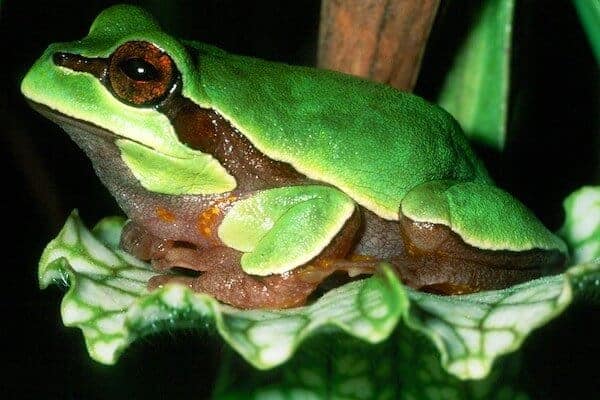
Scientific name: Hyla andersoni
Pine barrens tree frogs are round, plump green frogs with a brown or plum-colored band extending from their nostril to their back limb. Depending on stress or different weather conditions, they may also turn a dark olive green. Their calls are a series of high-pitched quank notes repeated rapidly.
You can find them in a small area in the southern counties of Alabama, including Escambia, Covington, and Geneva Counties. They prefer hillside seepage bogs along small stream valleys.
4. Bird-voiced tree frog
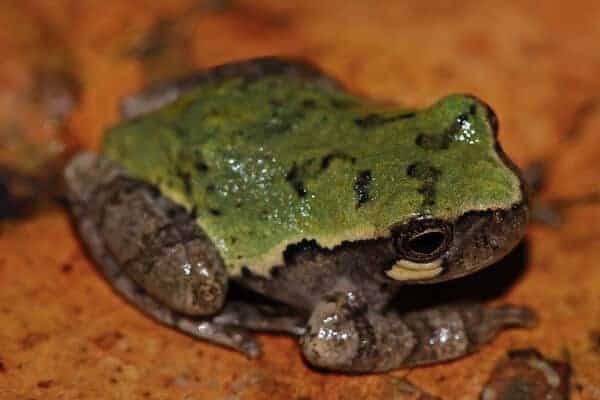
Scientific name: Hyla avivoca
The bird-voiced tree frog is a small, warty, slender frog ranging from 1.125 to 1.75 inches long, with females typically larger than males. Their coloring is brown, gray, or green with dark blotches and white spots with black borders under each eye.
You can find them in central and south Alabama by wooded swamps, beaver ponds, river valleys, and lakeshores. They are highly arboreal, commonly seen on trees such as birch, bald cypress, and tupelo.
5. Cope’s gray tree frog
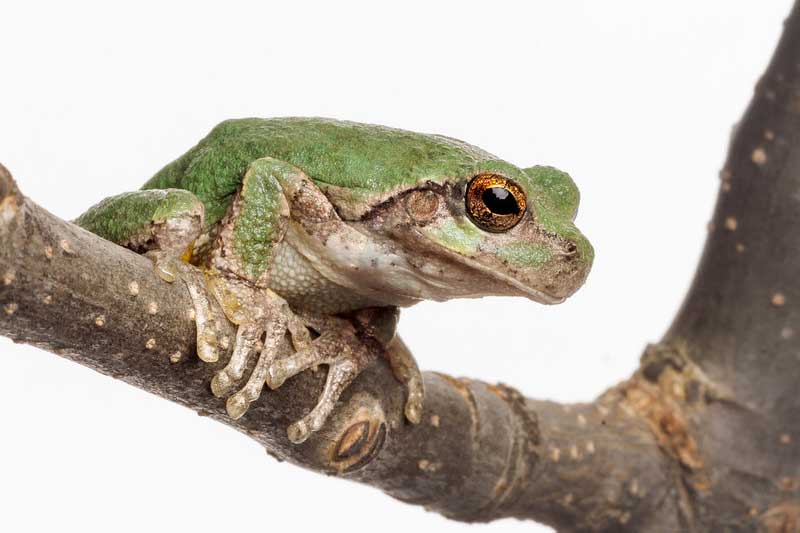
Scientific name: Hyla chrysoscelis
Cope’s gray tree frogs are dark gray to gray or brownish with several big blotches. They are fairly large, growing over 2 inches long. Unlike most frogs, this species is reluctant to jump and prefers climbing or walking while keeping their sticky toe pads flat against surfaces.
These frogs are common throughout Alabama but more abundant in deciduous forests. They prefer perching on high trees or shrubs near swamps and wooded ponds or streams.
6. Green tree frog

Scientific name: Hyla cinerea
Green tree frogs are large, slender, bright green frogs that can also be dull greenish-gray or yellowish. They are sometimes called rain frogs because they mostly call during damp weather or cowbell frogs because of the distinctive sound of their call.
They prefer wet habitats such as lakesides, stream edges, and swamps. Sometimes you can find them in brackish water. They live statewide in Alabama.
7. Pine woods tree frog

Scientific name: Hyla femoralis
Pine woods tree frogs are small, slender frogs growing up to 1.8 inches long. Depending on the environmental temperature, they are reddish or brown but can also be green or gray.
You can find them mostly in the Coastal Plain areas of Alabama. However, separate populations also live above the Fall Line and as far north as Shelby County. They typically live in longleaf pine habitats with sandy soils and spend most of their time hiding in forest trees when outside the breeding season.
8. Squirrel tree frog

Scientific name: Hyla squirella
Squirrel tree frogs are gray to light green or brown, with a white line along their upper jaw. They make a squirrel-like call that is also sometimes described as a raspy quack. These frogs are common neirghborhood visitors to patio or porch lights to catch insects at night.
You can find them mostly in the Coastal Plain region of Alabama. However, their range extends northeast through the Valley and Ridge region as far north as Etowah County. They breed in flatwood ponds, stock-watering ponds, and roadside ditches.
9. Little grass frog
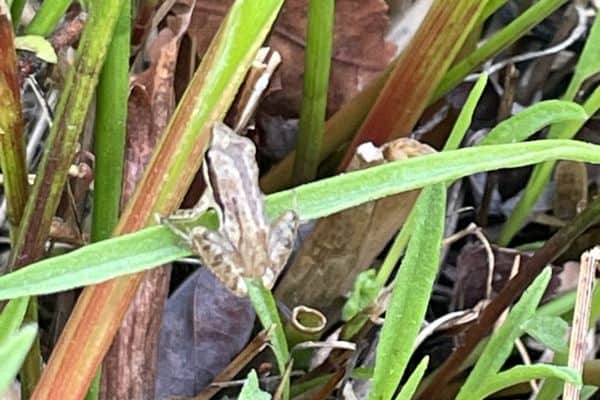
Scientific name: Pseudacris ocularis or Limnaoedus ocularis
The little grass frog lives up to their name by being one of the smallest land vertebrates in North America. They can be gray, brown, tan, or brick red, with dark brown stripes from the snout through the eye and down their side.
In Alabama, you can only find them in four locations in the southeastern corner of Houston County. They prefer sedge-dominated and open grass wetlands, including roadside ditches, pine flatwoods, savannas, and cypress ponds.
10. Spring peeper

Scientific name: Pseudacris crucifer
Spring peepers get their name from the high whistle peep call they make. From a distance, their large chorus can sound like sleigh bells. They are yellow, grey, olive, or brown frogs with a distinctive X pattern on their backs.
You can find them statewide in damp, wooded areas of Alabama. During the breeding season, from January to April, they live in or near ponds, swamps, or pools.
11. Barking tree frog
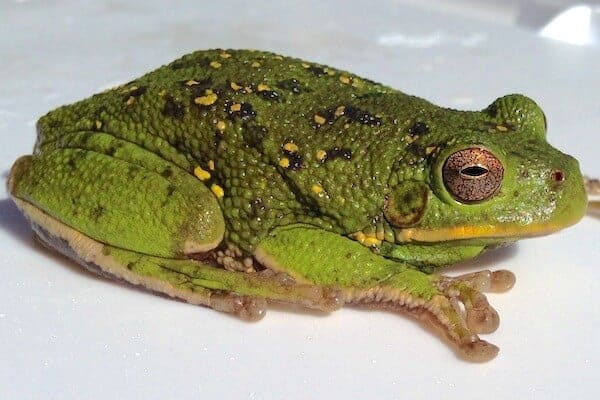
Scientific name: Hyla gratiosa
Barking tree frogs are plump and large frogs with granular back skin. Their coloring ranges from bright green to brown, with round dark spots. They get their name from the barking call they make. However, males can also make a loud toonk or doonk call when they are in the water.
You can find them statewide in Alabama, with the most populations in the southeastern region. These frogs are solitary and nocturnal as well as both climbers and burrowers. They spend winter and dry months burrowing in sandy soils and hang out in treetops during the warmer months.
12. Southern chorus frog

Scientific name: Pseudacris nigrita
Southern chorus frogs are small gray, tan, or brown frogs with bumpy skin. They have dark bands along their eyes and a white line running from their snout to upper lip. Their breeding call is a rasping, mechanical trill that resembles a ratchet-type wrench.
They are generally restricted to the Lower Coastal Plain region of Alabama. However, some populations live in an area east of the Conecuh River. These frogs prefer pine flatwood and sandhill habitats as well as breed in cypress ponds, grassy depressions, and bays.
13. Mountain chorus frog
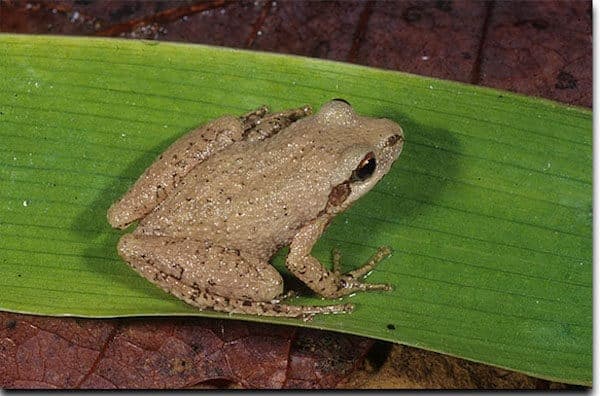
Scientific name: Pseudacris brachyphona
Mountain chorus frogs are gray to olive with lines on their back that can overlap to create an X pattern. They also sometimes have a dark triangle between the eyes. These small frogs grow between 1 to 1.5 inches long.
You can commonly find them from the Alabama Fall Line and northwards. They are absent from most of the Coastal Plain regions. They prefer breeding in hilly terrain in shallow pools in wooded areas.
14. Ornate chorus frog
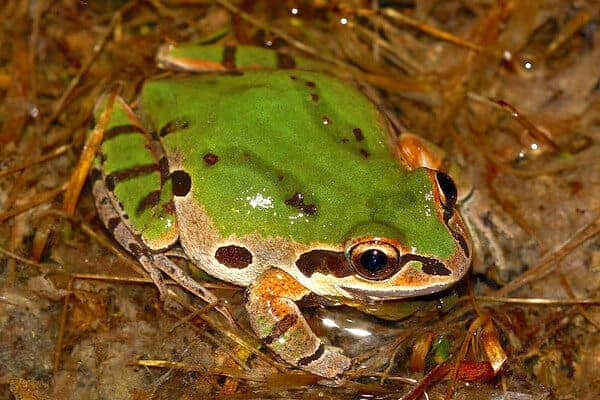
Scientific name: Pseudacris ornata
Stout and large, the ornate chorus frog grows up to 1.6 inches long. Their coloring includes brown, reddish-brown, gray, and bright green. They also have dark, bold stripes along the sides and through the eyes.
You can find these frogs in the southeast region of Alabama, extending into Mississippi along the coast. They prefer Coastal Plain forest habitats, such as pine flatwoods, sandhills, and upland pine forests.
15. Upland chorus frog

Scientific name: Pseudacris feriarum
Upland chorus frogs make a series of short trills consisting of repeated crreek sounds resembling fingers running over the teeth of a comb. They are brown to gray and usually have a dark triangle between their eyes. They typically also have dark stripes or spots on their back.
You can find these frogs nearly statewide in Alabama. However, they are absent from the extreme southern counties, except along the Chattahoochee and Conecuh Rivers. These nocturnal frogs prefer moist woodlands, grassy areas, ponds, bogs, marshes, and river-bottom swamps.
